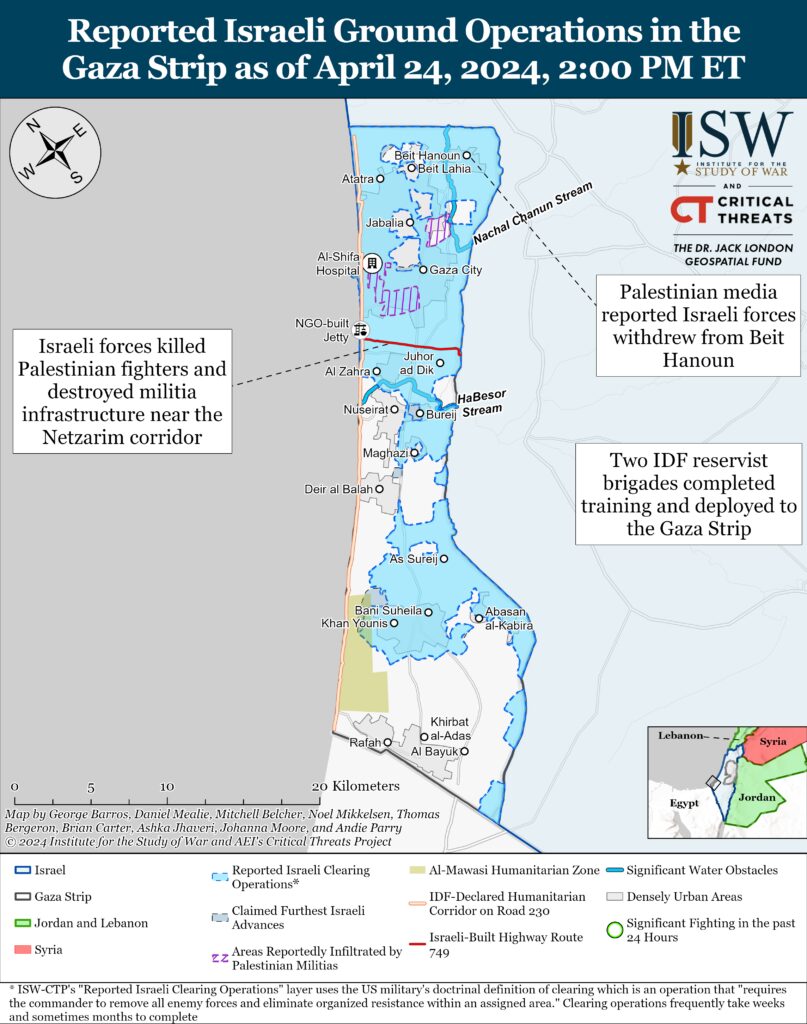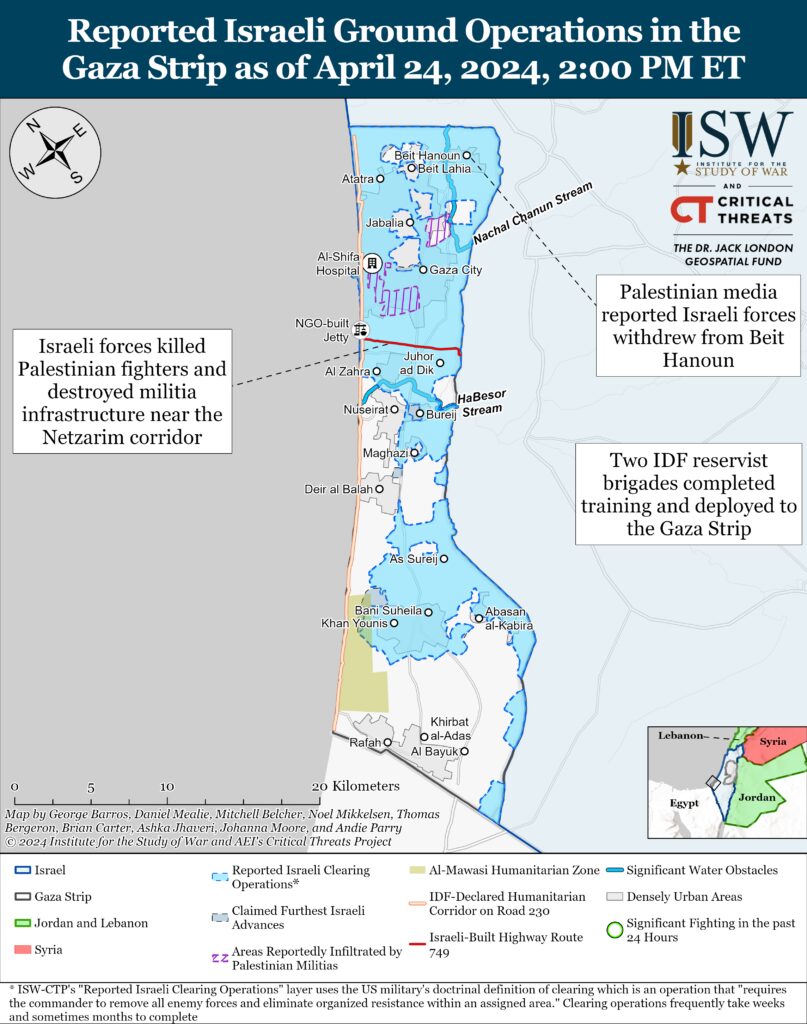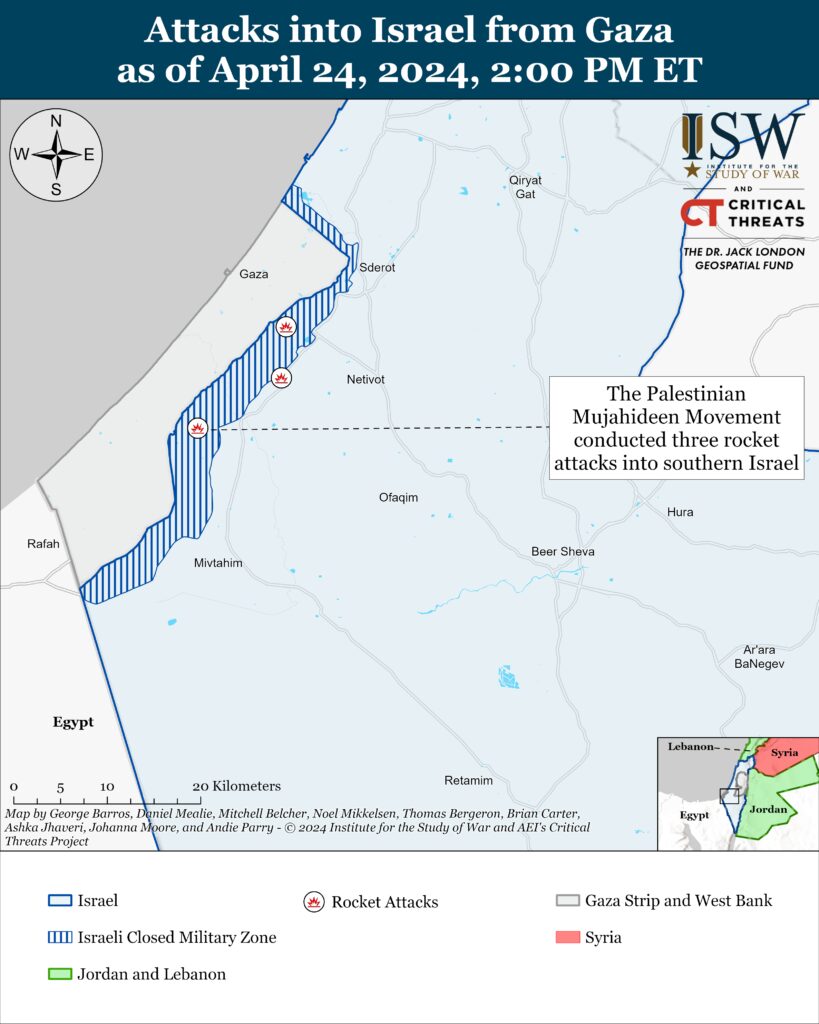Iranian-backed Iraqi militias appear divided on whether to resume attacks targeting US forces. Emirati state media reported that Iranian-backed Iraqi militia Kataib Hezbollah (KH) is advocating for the resumption of attacks but that some militia leaders disagree with KH, citing unidentified Iraqi political and security sources.[i] Emirati state media furthermore reported that the Islamic Resistance in Iraq, which is a coalition of Iranian-backed Iraqi militias, did not approve the recent attacks on US forces on April 21 and 22, citing unidentified sources “close to Baghdad and [the Iranian-backed Iraqi] armed factions.”[ii] These reported fissures are consistent with other recent reports that KH announced the resumption of attacks on US forces on April 22 and then later rescinded the announcement.[iii] KH pushing to restart attacks on American forces is unsurprising, moreover, since the group previously disputed orders from the IRGC Quds Force to halt attacks on US targets in February 2024.[iv] Iranian-backed Iraqi militia Faylaq al Waad al Sadiq (True Promise Corps) separately criticized unspecified Shia leaders on April 18 for abandoning their efforts to expel US forces, possibly suggesting that the group similarly wants to resume attacks.[v]
KH and other militias supporting the resumption of attacks are responding at least partly to the recent visit of Iraqi Prime Minister Mohammad Shia al Sudani to Washington, DC. Sudani discussed bilateral security cooperation with US officials during his visit, and his administration signaled that it had arrived at a timeline for the end of the US-led international coalition mission in Iraq.[vi] KH’s push to resume attacks suggests that it is dissatisfied with Sudani following the visit. Sudani does not seek the removal of US forces, as CTP-ISW previously reported, placing him at odds with some of the Iranian-backed Iraqi factions, including KH. These fissures highlight the risk that KH and other militias could resume regular attacks on US positions independently.
Iran is continuing to collaborate with other revisionist countries, such as Russia and North Korea, to advance their mutual agendas and undermine the West. Iranian Supreme National Security Council Secretary Rear Adm. Ali Akbar Ahmadian met with Russian counterpart, Nikolai Patrushev, on April 24 while attending the 12th Russian International Security Summit in St. Petersburg.[vii] Ahmadian and Patrushev signed a memorandum of understanding (MOU) to deepen bilateral security cooperation during their meeting.[viii] Iran separately hosted a state delegation from North Korea on April 23, marking the first to visit Tehran since 2019.[ix] North Korean External Economic Relations Minister Yun Jong Ho led the delegation, which is particularly noteworthy given his prominent involvement in North Korean cooperation with Russia.[x] Yun Jong Ho met with a Russian delegation in Pyongyang in December 2023 and later traveled to Moscow in March 2024.[xi] This flurry of meetings highlights the extent to which Iran, Russia, and North Korea are cooperating on several fronts in pursuit of their revisionist ambitions.
Iranian officials could discuss military and nuclear cooperation, among other things, with the North Korean delegation in Tehran. Iran and North Korea have a long history of such cooperation that began in the 1990s with the Iranian purchase of North Korean missile technologies.[xii] Some Western analysts have hypothesized that Iran could provide drones and/or energy products to North Korea in exchange for help with the Iranian missile and nuclear programs.[xiii] Pyongyang could furthermore seek to learn from the recent Iranian drone and missile attack on Israel and the performance of Iranian systems against US and partner air defenses.
Iran and North Korea are separately aligned in their military support for the Russian invasion of Ukraine. Iran has provided drones and other forms of support to Russia, as CTP-ISW has reported extensively.[xiv] North Korea has similarly given ballistic missiles to Russian forces to use against Ukrainian targets. Russia had fired around 50 North Korean-sourced missiles as of March 2024, according to Ukrainian officials.[xv]
Key Takeaways:
- Iraq: Iranian-backed Iraqi militias appear divided on whether to resume attacks targeting US forces.
- Iran: Iran is continuing to collaborate with other revisionist countries, such as Russia and North Korea, to advance their mutual agendas and undermine the West.
- Gaza Strip: Several Israeli defense and security officials told international media outlets that the IDF is fully prepared for a clearing operation into Rafah.
- West Bank: Israeli forces have engaged Palestinian fighters in at least five locations across the West Bank.
- Southern Lebanon and Golan Heights: The IDF Air Force conducted a “broad attack” on approximately 40 Lebanese Hezbollah targets around Aita al Shaab, near the Israel-Lebanon border.

Gaza Strip
Axis of Resistance objectives:
Erode the will of the Israeli political establishment and public to sustain clearing operations in the Gaza Strip
Reestablish Hamas as the governing authority in the Gaza StripLocal Palestinian sources reported that the Israel Defense Forces (IDF) withdrew from Beit Hanoun in the northern Gaza Strip on April 24.[xvi] EIKfir Brigade (99th Infantry Division) previously raided Palestinian military infrastructure, including tunnel shafts, there on April 22. Palestinian militias claimed attacks targeting Israeli forces in Beit Hanoun on April 22 but did not claim attacks on April 24, which is consistent with the claim that Israeli forces withdrew from Beit Hanoun.[xvii] The IDF did not comment on its activity in the northern Gaza Strip on April 24.
Local Palestinian sources reported extensive Israeli airstrikes and artillery fire on Beit Lahia in the northern Gaza Strip but no Israel ground force movement there on April 24. A Palestinian journalist reported that Israeli airstrikes and artillery fire targeted northern and central Beit Lahia overnight.[xviii] The IDF issued new evacuation orders for Beit Lahia on April 23, stating that Israeli forces would target Palestinian military infrastructure and “subversive elements” in the area.[xix] The IDF has frequently used fire to shape dense urban terrain in the Gaza Strip before ground elements move into areas.[xx]
Israeli forces continued to conduct clearing operations around the Netzarim corridor on April 23. The IDF Nahal Brigade (162nd Division) killed several Palestinian fighters and destroyed military infrastructure around the Netzarim corridor.[xxi] Israeli aircraft separately struck a tunnel shaft and several militia sites in the central Gaza Strip.[xxii] Hamas fighters mortared Israeli forces stationed on the Netzarim corridor in two separate attacks on April 24.[xxiii]
Two IDF reservist brigades completed training and deployed to the Gaza Strip on April 24.[xxiv] An Israeli Army Radio journalist reported on April 15 that the IDF 2nd Carmeli Brigade and 679th Armored Brigade would secure the Netzarim corridor and the temporary US-built pier in the central Gaza Strip.[xxv] The two brigades will replace elements of the 162nd Division, including the Nahal Brigade, enabling the division to conduct raids in other parts of the Gaza Strip.[xxvi] The Nahal Brigade’s commanding officer said on April 23 that the brigade anticipates that it will depart the Netzarim corridor bases soon for Rafah.[xxvii] Nahal Brigade soldiers said on April 23 that they are fortifying their positions along the Netzarim corridor as they expect Palestinian militias ”are trying to spoil our holidays with a high-quality attack” in the central strip.[xxviii] Palestinian militias could try to exploit the planned transfer of responsibility from one unit to another to conduct a particularly significant attack of some kind.
The IDF Gaza Division directed airstrikes on over 50 targets across the Gaza Strip over the past day.[xxix]

Gaza Strip
Axis of Resistance objectives:
Erode the will of the Israeli political establishment and public to sustain clearing operations in the Gaza Strip
Reestablish Hamas as the governing authority in the Gaza StripLocal Palestinian sources reported that the Israel Defense Forces (IDF) withdrew from Beit Hanoun in the northern Gaza Strip on April 24.[xvi] EIKfir Brigade (99th Infantry Division) previously raided Palestinian military infrastructure, including tunnel shafts, there on April 22. Palestinian militias claimed attacks targeting Israeli forces in Beit Hanoun on April 22 but did not claim attacks on April 24, which is consistent with the claim that Israeli forces withdrew from Beit Hanoun.[xvii] The IDF did not comment on its activity in the northern Gaza Strip on April 24.
Local Palestinian sources reported extensive Israeli airstrikes and artillery fire on Beit Lahia in the northern Gaza Strip but no Israel ground force movement there on April 24. A Palestinian journalist reported that Israeli airstrikes and artillery fire targeted northern and central Beit Lahia overnight.[xviii] The IDF issued new evacuation orders for Beit Lahia on April 23, stating that Israeli forces would target Palestinian military infrastructure and “subversive elements” in the area.[xix] The IDF has frequently used fire to shape dense urban terrain in the Gaza Strip before ground elements move into areas.[xx]
Israeli forces continued to conduct clearing operations around the Netzarim corridor on April 23. The IDF Nahal Brigade (162nd Division) killed several Palestinian fighters and destroyed military infrastructure around the Netzarim corridor.[xxi] Israeli aircraft separately struck a tunnel shaft and several militia sites in the central Gaza Strip.[xxii] Hamas fighters mortared Israeli forces stationed on the Netzarim corridor in two separate attacks on April 24.[xxiii]
Two IDF reservist brigades completed training and deployed to the Gaza Strip on April 24.[xxiv] An Israeli Army Radio journalist reported on April 15 that the IDF 2nd Carmeli Brigade and 679th Armored Brigade would secure the Netzarim corridor and the temporary US-built pier in the central Gaza Strip.[xxv] The two brigades will replace elements of the 162nd Division, including the Nahal Brigade, enabling the division to conduct raids in other parts of the Gaza Strip.[xxvi] The Nahal Brigade’s commanding officer said on April 23 that the brigade anticipates that it will depart the Netzarim corridor bases soon for Rafah.[xxvii] Nahal Brigade soldiers said on April 23 that they are fortifying their positions along the Netzarim corridor as they expect Palestinian militias ”are trying to spoil our holidays with a high-quality attack” in the central strip.[xxviii] Palestinian militias could try to exploit the planned transfer of responsibility from one unit to another to conduct a particularly significant attack of some kind.
The IDF Gaza Division directed airstrikes on over 50 targets across the Gaza Strip over the past day.[xxix]



Top Israeli military and intelligence officials met with Egyptian officials in Cario on April 24 about an Israeli operation into Rafah, according to sources cited by Axios.[xxx] The Israeli delegation included Shin Bet head Ronen Bar and IDF Chief of Staff Herzi Halevi who last met with Egyptian intelligence officials in mid-February.[xxxi] Several Egyptian officials have spoken to international media about Israeli’s plans for Rafah. Israeli security officials are likely discussing the current plans for an operation into Rafah, given Israel’s intention to clear and station Israeli guards along the 14-kilometer-long strip of land between Egypt and the Gaza Strip known as the Philadelphi corridor.[xxxii] The IDF seeks to clear the corridor to subvert Palestinian militia’s smuggling and tunnel routes out of the Gaza Strip as part of the dismantling of Hamas.[xxxiii]
Several Israeli defense and security officials told international media outlets on April 24 that the IDF is fully prepared for a clearing operation into Rafah.[xxxiv] An Israeli defense official said that IDF is only waiting for approval from Israeli Prime Minister Benjamin Netanyahu.[xxxv] Another senior Israeli official said the directive to begin evacuating civilians from Rafah is ”parked at his desk.”[xxxvi] Other Israeli government sources reported that the war cabinet ”planned to meet in the coming two weeks to authorize civilian evacuations,“ which are expected to take about a month.[xxxvii] A spokesperson for Netanyahu’s government told Reuters that Israel was “moving ahead” with a ground operation but gave no timeline.[xxxviii]
Israeli officials told Axios that over 250,000 civilians have left Rafah since the IDF concluded its clearing operations around Khan Younis on April 7.[xxxix] Senior US officials said that some of those people had returned to Rafah after they realized ”that the infrastructure and houses in Khan Younis were completely destroyed.”[xl] Commercially available satellite imagery supports claims by Israeli officials that Egypt and the United Arab Emirates have established large tent shelters between Khan Younis and in the al Mawasi humanitarian area.[xli]
The Palestinian Mujahadeen Movement conducted three rocket attacks from the Gaza Strip targeting southern Israel on April 24. The militia targeted three separate towns.[xlii] The militia stated the rocket launches were meant to commemorate the death anniversary of the group’s founder.[xliii] The Palestinian Mujahideen Movement is a Palestinian faction aligned with Hamas and has expressed close ties with Iran.[xliv]

Recorded reports of attacks; CTP-ISW cannot independently verify impact.
West Bank
Axis of Resistance objectives:
Establish the West Bank as a viable front against IsraelIsraeli forces have engaged Palestinian fighters in at least five locations across the West Bank since CTP-ISW’s last information cutoff on April 23.[xlv] PIJ fighters fired small arms and detonated improvised explosive devices (IED) targeting Israeli forces in Tulkarm and Nour Shams refugee camp.[xlvi] The al Aqsa Martyrs’ Brigades clashed with Israeli forces overnight in Beit Ummar, north of Hebron.[xlvii] Al Aqsa Martyrs’ Brigades fighters also fired small arms and detonated IEDs targeting Israeli forces in Askar refugee camp on April 24.[xlviii]
The IDF reported that Israeli forces killed a Palestinian woman who tried to stab Israeli soldiers at a military checkpoint in Kiryat Arba, Hebron.[xlix]

This map is not an exhaustive depiction of clashes and demonstrations in the West Bank.
Southern Lebanon and Golan Heights
Axis of Resistance objectives:
Deter Israel from conducting a ground operation into Lebanon
Prepare for an expanded and protracted conflict with Israel in the near term
Expel the United States from SyriaLebanese Hezbollah has conducted at least seven attacks from southern Lebanon into northern Israel since CTP-ISW’s last data cutoff on April 23.[l]
The IDF Air Force conducted a “broad attack” on approximately 40 Lebanese Hezbollah targets around Aita al Shaab, near the Israel-Lebanon border, on April 24.[li] The IDF targeted Hezbollah storage facilities, weapons depots, and unspecified militia infrastructure in the area with aircraft and artillery.[lii] The IDF stated that the attack was part of the ongoing Israeli effort to destroy Hezbollah’s infrastructure along the border and noted that Hezbollah makes ”extensive use” of the Aita al Shaab area to organize and conduct attacks into Israel.[liii] Hezbollah released statements claiming that it conducted four attacks into northern Israel in retaliation for the Israeli airstrikes.[liv]
Israeli Defense Minister Yoav Gallant stated that the IDF has killed “half of Hezbollah’s commanders in southern Lebanon” during a visit to the IDF’s Northern Command in Safed, Israel, on April 24.[lv] Gallant added that the remaining Hezbollah commanders have gone into hiding in other regions.[lvi] A Lebanese official “close to Hezbollah” refuted Gallant’s estimate to the Washington Post on April 24 and stated that the number of Hezbollah commanders killed by the IDF could be “counted on one hand.” [lvii] Gallant said that the IDF’s main objective in northern Israel is to allow displaced residents to return to their homes and that the IDF is considering “a number of alternatives” to accomplish the goal.[lviii]

Recorded reports of attacks; CTP-ISW cannot independently verify impact.
Iran and Axis of Resistance
Iranian President Ebrahim Raisi traveled to Sri Lanka and expressed eagerness to deepen bilateral economic ties on April 24.[lix] Raisi’s visit marks the first time that an Iranian president has traveled to Sri Lanka since 2008. Raisi met with Sri Lankan President Ranil Wickremesinghe and signed five memoranda of understanding (MOU) on media, technical, and tourism cooperation.[lx] Raisi inaugurated a 514-million-dollar hydropower and irrigation project built by an Iranian contractor in Sri Lanka.[lxi] Raisi visited Sri Lanka immediately following his trip three-day trip to Pakistan.[lxii]
Supreme Leader Ali Khamenei stated that Iran will turn sanctions into “opportunities” during a speech to Iranian workers on April 24.[lxiii] Khamenei stated that the United States seeks to impose additional sanctions against Iran and disrupt the Iranian nuclear industry. Khamenei emphasized the importance of the individual worker to increase the overall economic output of the country and combat Western sanctions. Khamenei’s speech comes as Iran continues to face a severe economic crisis.[lxiv] CNBC reported that the Iranian rial reached a record low of 705,000 to the dollar on April 14.[lxv] Khamenei separately reiterated regime support for the anti-Israel protesters in Western countries.
Iranian Foreign Affairs Ministry spokesperson Nasser Kanani criticized the United States for the treatment of anti-Israel protesters on college campuses in a statement on X (Twitter) on April 24.[lxvi]
The Iranian judiciary sentenced a 33-year-old dissident to death on April 24 as part of an expanding crackdown on anti-regime attitudes. An Iranian revolutionary court sentenced Iranian rapper Toomaj Salehi to death on the charge that he supported the 2022-23 Mahsa Amini protest movement in Iran.[lxvii] The Iranian Supreme Court previously ruled against the death penalty for Salehi in 2023, and the judiciary instead sentenced him to over six years in prison. Salehi’s lawyer stated that the revolutionary court ignored the Supreme Court’s initial ruling and issued new charges against him.[lxviii] Salehi has until May 14 to appeal the ruling. This ruling coincides with the regime launching a renewed crackdown on women not adhering to the mandatory hijab law in recent days.[lxix]
 Eurasia Press & News
Eurasia Press & News




